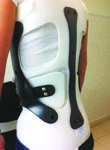Researchers from France have developed a carbon bracing system for patients with scoliosis that has high compliance rates and reduces the impact on vital capacity (VC)-the maximum amount of air a person can expel from the lungs after a maximum inhalation-which researchers deem is a quality-of-life improvement over the more familiar and more rigid Lyon brace. They also said the carbon brace can be used at a very young age without disrupting the chest growth, but should be kept for reducible scoliosis in older teenagers, whereas the Lyon brace treatment can only be started around puberty. The Corset Monocoque Carbone respectant la Respiration (CMCR), which translates as “monoshell carbon brace respecting breathing,” treats progressive thoracic, thoracolumbar, or combined scoliosis.

Photograph courtesy of the journal Scoliosis.
The brace was presented online February 14 in the journal Scoliosis. The article includes, among other things, summaries of prior studies, a description of the brace; theoretical principles; how to prescribe, build, and fit the brace; and protocols.
The CMCR monoshell is made of polyethylene and reinforced with prestressed carbon fiber braids that create support forces on the system of adjustable and mobile brace pads. This support keeps some mobility during movements, especially in respiratory ones, while also providing a permanent pressure, which varies depending on ribs and spine movements. In contrast, the Lyon brace is made of plexidur, a thermoplastic, and structured with metal reinforcements and adjustable but fixed localized support pads.
Summaries of the CMCR usage studies follow: In the first retrospective study of 115 patients, French-published in the Annals of Physical Medicine and Rehabilitation (2005), the CMCR brace stabilized moderate scoliosis, decreased the VC of 13 percent compared to the VC without the brace, and did not have sufficient impact on the hump reduction. Treatment had better results when started at Risser 3 or 4 than Risser 0, 1, or 2. The brace was then modified to increase the dorsal pad pressure and the location of correction forces was defined more precisely through the use of three-dimensional (3D) analysis. The second study, published in Scoliosis (2011), mainly focused on the impact on VC at brace setup and followed a cohort of 90 patients treated with the CMCR. Girls as well as boys increased VC during treatment, and at brace definitive removal, VC had increased 21 percent from the initial value, whereas the theoretical VC at the same time rose by 18 percent.
The researchers offered the CMCR as an alternative to rigid braces and concluded that the CMCR brace is innovative for, among other reasons, the materials used prevent chest movements while preserving respiratory capacity during brace usage, the mobile pads used to gradually correct scoliosis conform to stiffness areas that will appear throughout patient growth, and the orthosis is designed to partly maintain spine and chest mobility.




